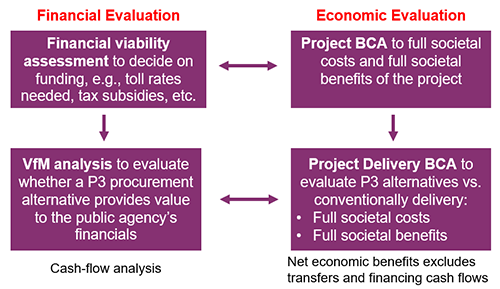Tables
Figures
A proposed P3 project may be evaluated (a) using financial analysis to evaluate its financial impact on the budget of the procuring agency; and/or (b) using benefit-cost analysis to compare societal benefits against societal costs, i.e., economic efficiency analysis. Each type of evaluation is described further below in the context of the project delivery process. The Figure below shows the relationship between financial and economic evaluation.
Figure 1. Financial Evaluation vs. Economic Evaluation

View larger version of Figure 1
Project delivery financial evaluation will generally include an analysis of Financial Viability and Value for Money (VfM). Financial Viability Analysis evaluates the feasibility of the project on the basis of all the financial cash flows, including the ability to pay for the project through existing or potential new revenue streams. This may initially be done assuming conventional delivery. At a later stage, if a decision is made to consider P3 delivery, the analysis may again be undertaken assuming P3 delivery. VfM analysis can then be used to compare the P3 option to conventional procurement.
The focus of this guide is on a process for comprehensive evaluation of societal benefits and costs associated with P3 design-build-finance-operate-maintain (DBFOM) project delivery. In the context of P3 project delivery, this analysis - the PDBCA - may be conducted in three steps:
The first two steps assume conventional delivery of the project.1 In the final step, the efficiency impacts relating directly to P3 procurement are estimated relative to accelerated conventional delivery of the project. This will include impacts of a P3 on costs, schedule, quality of service and travel demand relative to accelerated conventional delivery, as well as impacts of any modifications to scope proposed by a P3 bidder in response to a Request for Proposals (RFP). The economic efficiency analysis in the final step parallels VfM analysis, which (necessarily) assumes that conventional procurement is possible in the same time frame as the P3.
The rest of this guide describes how a State Department of Transportation (DOT) might apply the PDBCA framework ex ante, i.e., before bids are received. Two alternative delivery methods for a major project are compared:
As depicted in Figure 2, the State DOT would compare the two project delivery methods as follows using the three-step process:
Figure 2: Benefit-Cost Analysis Framework
View larger version of Figure 2
1 Step 2 accounts for situations where the public agency does not expect that conventional delivery would be possible in the same time frame as the P3, due to budgetary or debt capacity constraints. If this is not the case, then this step in the analytical framework could be skipped.